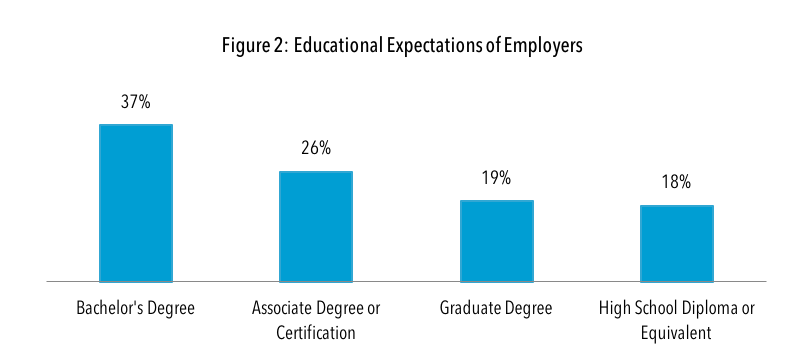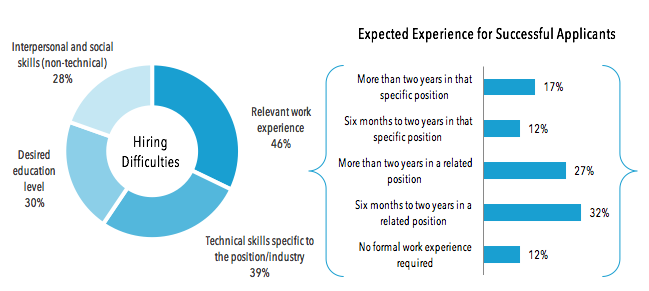Sarah Burns is Research Manager at the San Diego Workforce Partnership. Here she answers some questions about one of the department’s latest labor market reports, In-Demand Jobs 2016, which uses employer feedback and labor market data to profile San Diego County’s top occupations.
Which industry(ies) have the most in-demand jobs?
We look at occupations through the lens of San Diego’s five Priority Sectors — Advanced Manufacturing, Life Sciences, Clean Energy, Health Care and Information and Communication Technologies (ICT). Fifty-two of the 55 job profiles fall into one or more of these Priority Sectors. I think it’s really great for job seekers that twenty of them can be found in all five sectors. These are jobs with highly transferrable skills that nearly every company needs to operate. Nine of them are primarily categorized as ICT, which makes sense because companies in every industry rely on IT professionals to help their company run efficiently. The other 11 are mainly legal, marketing and administrative positions, which are also used by every industry.
On the other end of the spectrum, we profiled 21 occupations that are only found in a single Priority Sector, the majority (16) being in Health Care. This is to be expected, as many Health Care occupations are highly specialized and the industry is experiencing constant growth due to an aging baby boomer population. These profiles include doctors and nurses — the first two careers we typically think of in Health Care — but they also expose job seekers to some less obvious occupations like medical records and health information technicians.
It’s also interesting to look at the seven occupations that fall into two Priority Sectors. These jobs represent just two pairings: Life Sciences/Health Care and Advanced Manufacturing/Clean Energy. This is a good sign of job security for workers, as it suggests that many of these occupations build skills that are transferrable to the other sector. You can see the complete distribution across industries in the diagram below.

How much do these occupations pay?
For this list, jobs only made the cut if they offer a median hourly wage at or above $13.09, the San Diego living wage.1 Half of the occupations on the full list of 154 jobs (Appendix D) pay a median hourly wage between $20.19 and $41.25, or between $41,995 and $85,800 annually. The lower twenty-five percent of In-Demand jobs pay a median hourly wage between $13.28 and $20.19 ($27,622 to $41,995 annually) and the upper twenty-five percent pay $40.25 to $110.75 per hour ($41,995 to $230,360 annually).
What types of education are required for these jobs?
We surveyed more than 400 employers to get much of the data in the report, and according to their responses 44 percent of the profiled jobs require less than a bachelor’s degree. These are great entry-level positions for job seekers who want to get to work quickly or who are not interested in four-year degree programs for other reasons. Employers are looking for bachelor’s degrees for 37 percent of these jobs, and graduate degrees for 19 percent.
Occupations were only included on the In-Demand Jobs list if they typically require at least a high school diploma for entry-level employment because that minimum level of education opens the door for career advancement in any occupation.

What kinds of skills and experience are employers looking for when hiring for these jobs?
Employers looking to hire in the next 12 months reported several challenges in finding what they need in the workforce. The most common hiring difficulty faced is finding workers with relevant work experience. Unsurprisingly, 88 percent of employers are looking for candidates with relevant work experience. It is, however, worth noting that most employers (59 percent) are open to applicants with experience in a related position rather than the same exact position they are applying for. This means that there is generally room for experienced job seekers to transition into new positions, even when their past experience does not match up perfectly.

How can job seekers use this information in their job search?
The 2016 In-Demand Jobs List will help job seekers focus their job search by matching personal interests and priorities with a job that can lead to a sustainable and rewarding career pathway. Because every occupation in this report is growing, job seekers can pursue training and employment in these areas with the knowledge that they will have long-term job security. The profiles provide high-level snapshots of careers in a variety of industries, with a range of experience and educational expectations, with the hope that any job seeker can use this tool as a starting point on the way to a successful career.
As job seekers review the profiles, it may be useful to make a list of occupations that they find appealing and record information that is important to them. This will help to compare occupations without having to flip between pages. Anyone can quickly make a table like this one on a sheet of paper:

Additionally, career counselors, educators, case workers and employers can use the profiles to promote occupations to job seekers. The report can be downloaded at workforce.org/reports, and individual profile pages can be printed to distribute as flyers.
1Self-Sufficiency Standard developed by Insight Center for Community Economic Development and adopted for San Diego by Center on Policy Initiatives: cpisandiego.org/making_ends_meet.
